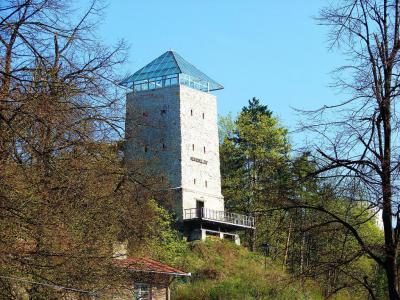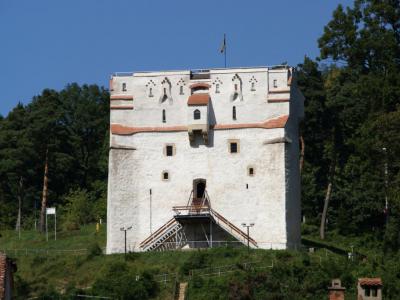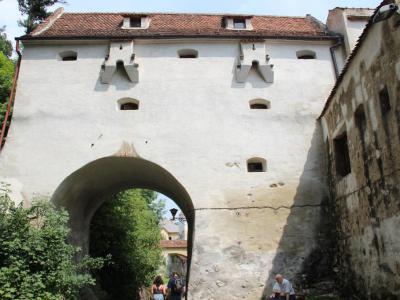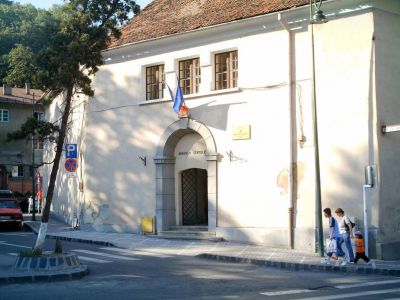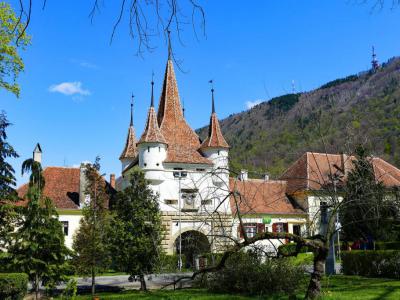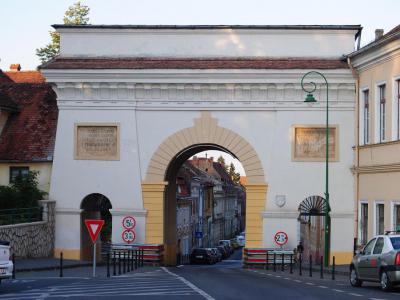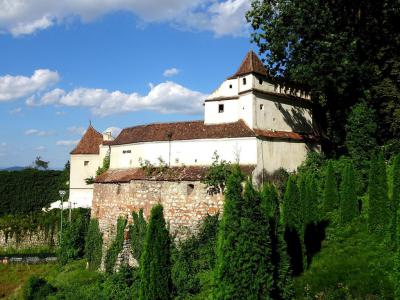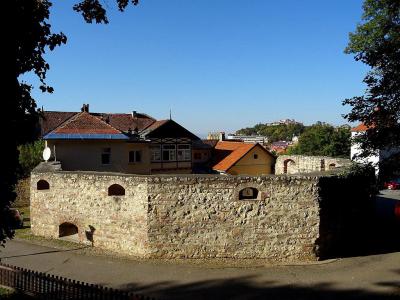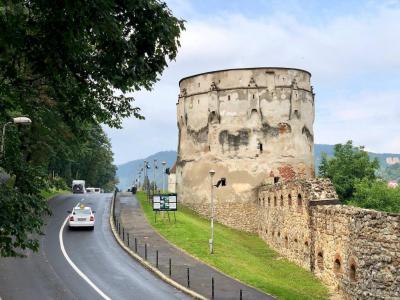Brasov Fortifications Tour (Self Guided), Brasov
Frequent invasions by Turkish Tatars throughout the 13th-15th centuries prompted Brasov residents to build fortifications around the town. At some point, Brasov came to be known as the “stronghold of seven bastions.” Remarkably, six of them are still in place. As for the other defensive structures placed between those bastions, most of them eventually succumbed to ruin, with only a few remaining.
Among the prominent fortification landmarks, which stand tall as the symbols of the city's medieval defenses, are the Black Tower (Turnul Negru) and the White Tower (Turnul Alb). The Graft Bastion (Bastionul Graft) and the Smiths' Bastion (Bastionul Fierarior) further demonstrate the strategic planning of Brasov's fortifications, offering insights into the architectural prowess of the time.
Catherine's Gate (Poarta Ecaterinei) and Scaffold's Gate (Poarta Schei) served as vital entry points to the city, each bearing its own historical significance. These gates were crucial in controlling access and ensuring the security of Brasov's inhabitants.
Additionally, the Weavers' Bastion (Bastionul Tesatorilor), Spinners' Bastion (Bastionul Funarilor), Drapers' Bastion (Bastionul Postavarilor), and Furriers’ Bastion (Bastionul Cojocarilor) attest to the diverse crafts and trades once flourished within the city walls.
These fortifications serve as reminders of the resilience and ingenuity of the people of Brasov. Visitors to the city can immerse themselves in the mystic atmosphere of these architectural marvels. So, take the opportunity to wander through the streets of Brasov and discover the stories woven into its walls, gates, and bastions.
Among the prominent fortification landmarks, which stand tall as the symbols of the city's medieval defenses, are the Black Tower (Turnul Negru) and the White Tower (Turnul Alb). The Graft Bastion (Bastionul Graft) and the Smiths' Bastion (Bastionul Fierarior) further demonstrate the strategic planning of Brasov's fortifications, offering insights into the architectural prowess of the time.
Catherine's Gate (Poarta Ecaterinei) and Scaffold's Gate (Poarta Schei) served as vital entry points to the city, each bearing its own historical significance. These gates were crucial in controlling access and ensuring the security of Brasov's inhabitants.
Additionally, the Weavers' Bastion (Bastionul Tesatorilor), Spinners' Bastion (Bastionul Funarilor), Drapers' Bastion (Bastionul Postavarilor), and Furriers’ Bastion (Bastionul Cojocarilor) attest to the diverse crafts and trades once flourished within the city walls.
These fortifications serve as reminders of the resilience and ingenuity of the people of Brasov. Visitors to the city can immerse themselves in the mystic atmosphere of these architectural marvels. So, take the opportunity to wander through the streets of Brasov and discover the stories woven into its walls, gates, and bastions.
How it works: Download the app "GPSmyCity: Walks in 1K+ Cities" from Apple App Store or Google Play Store to your mobile phone or tablet. The app turns your mobile device into a personal tour guide and its built-in GPS navigation functions guide you from one tour stop to next. The app works offline, so no data plan is needed when traveling abroad.
Brasov Fortifications Tour Map
Guide Name: Brasov Fortifications Tour
Guide Location: Romania » Brasov (See other walking tours in Brasov)
Guide Type: Self-guided Walking Tour (Sightseeing)
# of Attractions: 9
Tour Duration: 2 Hour(s)
Travel Distance: 2.8 Km or 1.7 Miles
Author: ellen
Sight(s) Featured in This Guide:
Guide Location: Romania » Brasov (See other walking tours in Brasov)
Guide Type: Self-guided Walking Tour (Sightseeing)
# of Attractions: 9
Tour Duration: 2 Hour(s)
Travel Distance: 2.8 Km or 1.7 Miles
Author: ellen
Sight(s) Featured in This Guide:
- Black Tower (Turnul Negru)
- White Tower (Turnul Alb)
- Graft Bastion (Bastionul Graft)
- Smiths' Bastion (Bastionul Fierarior)
- Catherine's Gate (Poarta Ecaterinei)
- Scaffold's Gate (Poarta Schei)
- Weavers' Bastion (Bastionul Tesatorilor)
- Spinners' Bastion (Bastionul Funarilor)
- Drapers' Bastion (Bastionul Postavarilor) and Furriers’ Bastion (Bastionul Cojocarilor)
1) Black Tower (Turnul Negru)
The Black Tower in Brasov is a prominent historical structure originally built in the 15th century, sharing its period of erection with the nearby White Tower. Positioned just outside the Brasov Citadel walls, on a rock of Warthe Hill, and near the Blacksmiths' Bastion, the tower served as a critical part of the city's defense system, especially against approaches from the Schei area.
Standing over 11 meters high and covering an area of 50 square meters, the Black Tower features robust walls that are 2 meters thick at the base. Designed for defense, it has six firing holes on each side, strategically arranged in three rows for optimal coverage. Inside, it comprises three-storied galleries that were historically accessible via a drawbridge linking it to the Citadel.
The tower's name derives from the aftermath of a fire in 1689, which blackened its walls. This fire, along with a lightning strike in 1559, destroyed the original roof-a feature that underwent multiple reconstructions, the most recent being after the tower was damaged significantly by torrential rain in 1991. Despite various appeals for restoration over the centuries, consistent upkeep was neglected until significant efforts in 1901 and a full restoration in 1996.
Historically, the Black Tower has played various roles, including acting as a lookout during the 1756 plague epidemic. Today, it houses a museum, offering visitors insights into its storied past and a panoramic view of the surrounding area, making it a significant historical landmark in Brasov.
Standing over 11 meters high and covering an area of 50 square meters, the Black Tower features robust walls that are 2 meters thick at the base. Designed for defense, it has six firing holes on each side, strategically arranged in three rows for optimal coverage. Inside, it comprises three-storied galleries that were historically accessible via a drawbridge linking it to the Citadel.
The tower's name derives from the aftermath of a fire in 1689, which blackened its walls. This fire, along with a lightning strike in 1559, destroyed the original roof-a feature that underwent multiple reconstructions, the most recent being after the tower was damaged significantly by torrential rain in 1991. Despite various appeals for restoration over the centuries, consistent upkeep was neglected until significant efforts in 1901 and a full restoration in 1996.
Historically, the Black Tower has played various roles, including acting as a lookout during the 1756 plague epidemic. Today, it houses a museum, offering visitors insights into its storied past and a panoramic view of the surrounding area, making it a significant historical landmark in Brasov.
2) White Tower (Turnul Alb)
The White Tower, or "Turnul Alb" in Romanian, is a testament to the medieval might and architectural acumen of the Saxons who built it between 1460 and 1494. Originally constructed as part of the city's fortifications against the Turks and Tartars, this robust, semicircular structure is a blend of massiveness and elegance, rising impressively above the city of Brasov.
Perched atop a steep hill, the White Tower reaches a height of 20 meters on the city side and 18 meters on the hillside, with its walls thickening to 4 meters at the base. The strategic design includes battlements, pitch mouths for defense, and balconies supported by intricately carved stone corbels, indicating the tower's role in warfare. Notably, it was the highest point of fortification in Brasov, serving as a critical observation and defense post.
This five-story tower is distanced 59 meters from the fortress wall, historically connected by a drawbridge to the Graft Bastion, enhancing its defensive capabilities. Inside, it retains a chimney above a hearth, a feature that provided warmth to the guards and defenders-mostly tinsmiths and coppersmiths. The guild of tinners, responsible for the tower's defense, relinquished their duty in 1678 due to diminishing numbers.
The White Tower suffered significant damage from a great fire on April 21, 1689, which led to its renovation in 1723. Subsequent restorations were carried out in the 20th and early 21st centuries, ensuring the preservation of its historical integrity.
Today, the White Tower functions not only as a historical monument but also as a museum. Visitors are invited to climb the 200 steep stone steps to the top, where they are rewarded with breathtaking panoramic views of Brasov. The tower also hosts temporary exhibitions, showcasing local artists and craftsmen, thus continuing its legacy as a beacon of the city's cultural and historical heritage.
Perched atop a steep hill, the White Tower reaches a height of 20 meters on the city side and 18 meters on the hillside, with its walls thickening to 4 meters at the base. The strategic design includes battlements, pitch mouths for defense, and balconies supported by intricately carved stone corbels, indicating the tower's role in warfare. Notably, it was the highest point of fortification in Brasov, serving as a critical observation and defense post.
This five-story tower is distanced 59 meters from the fortress wall, historically connected by a drawbridge to the Graft Bastion, enhancing its defensive capabilities. Inside, it retains a chimney above a hearth, a feature that provided warmth to the guards and defenders-mostly tinsmiths and coppersmiths. The guild of tinners, responsible for the tower's defense, relinquished their duty in 1678 due to diminishing numbers.
The White Tower suffered significant damage from a great fire on April 21, 1689, which led to its renovation in 1723. Subsequent restorations were carried out in the 20th and early 21st centuries, ensuring the preservation of its historical integrity.
Today, the White Tower functions not only as a historical monument but also as a museum. Visitors are invited to climb the 200 steep stone steps to the top, where they are rewarded with breathtaking panoramic views of Brasov. The tower also hosts temporary exhibitions, showcasing local artists and craftsmen, thus continuing its legacy as a beacon of the city's cultural and historical heritage.
3) Graft Bastion (Bastionul Graft)
The Graft Bastion is a vital component of the medieval fortifications of Brasov. Constructed between 1515 and 1521, this rectangular bastion was a critical link connecting the White Tower with the fortress. It played a key role in bolstering the defense of the citadel's northwestern side, positioned strategically near the channelized Graft stream at the base of the fortress walls.
The bastion was managed and defended by the saddlers' guild, showcasing the significant contribution of Brasov's craftsmen to the city's defenses. Its structure features walls approximately 4 meters thick at the base, firing holes, and oil spouts-elements that remain intact to this day. The bastion's two floors and a bridge allowed defenders to maintain a stronghold over the Graft canal, which served both as a natural obstacle and a drainage channel for excess water from Schei.
Over time, the bastion underwent various modifications. A major flood in 1809 severely weakened the foundations of the outer walls, prompting city architects to construct three supporting arches over the stream in 1822. However, two of these arches and part of the wall were later removed during 20th-century developments, including the construction of a residential house and a cinema exit.
Renovated in 2004-2005, the bastion now houses a section of the Brasov County History Museum. Its exhibition on the second floor includes medieval weapons, armor, and informative panels about the city's fortifications. A steep path restored with steps leads visitors from the bastion to the White Tower, offering an immersive glimpse into Brasov's historical defenses.
Legends tie the fortification of Brasov to King Sigismund of Luxemburg's campaign against the Turks in 1395. The city's defensive system, continually reinforced until the 17th century, proved remarkably effective. Despite Ottoman sieges and other threats, Brasov remained unconquered until the arrival of Austrian troops in 1688.
The Graft Bastion stands as a testament to Brasov's resilient fortifications, the craftsmanship of its guilds, and the city's rich medieval history.
The bastion was managed and defended by the saddlers' guild, showcasing the significant contribution of Brasov's craftsmen to the city's defenses. Its structure features walls approximately 4 meters thick at the base, firing holes, and oil spouts-elements that remain intact to this day. The bastion's two floors and a bridge allowed defenders to maintain a stronghold over the Graft canal, which served both as a natural obstacle and a drainage channel for excess water from Schei.
Over time, the bastion underwent various modifications. A major flood in 1809 severely weakened the foundations of the outer walls, prompting city architects to construct three supporting arches over the stream in 1822. However, two of these arches and part of the wall were later removed during 20th-century developments, including the construction of a residential house and a cinema exit.
Renovated in 2004-2005, the bastion now houses a section of the Brasov County History Museum. Its exhibition on the second floor includes medieval weapons, armor, and informative panels about the city's fortifications. A steep path restored with steps leads visitors from the bastion to the White Tower, offering an immersive glimpse into Brasov's historical defenses.
Legends tie the fortification of Brasov to King Sigismund of Luxemburg's campaign against the Turks in 1395. The city's defensive system, continually reinforced until the 17th century, proved remarkably effective. Despite Ottoman sieges and other threats, Brasov remained unconquered until the arrival of Austrian troops in 1688.
The Graft Bastion stands as a testament to Brasov's resilient fortifications, the craftsmanship of its guilds, and the city's rich medieval history.
4) Smiths' Bastion (Bastionul Fierarior)
The Blacksmith Bastion (Bastionul Fierarilor) in Brasov is a remarkable relic of the city’s medieval fortifications, steeped in history and architectural charm. Situated in a corner of Brasov’s historic fortress, this pentagonal structure was first documented in 1521 and played a critical role in defending the city. Equipped with shooting holes and openings for pouring pitch, the bastion demonstrates the ingenuity of medieval defensive design.
Over the centuries, the bastion endured damage from severe rains and floods. It underwent significant reconstruction in the early 18th century, resulting in the structure we see today. In 1923, it transitioned from a defensive bastion to a center of knowledge, becoming the headquarters of the Brasov Archives. These archives, transferred from the Council House to the bastion, remain housed there, preserving vital historical documents.
Although the interior is not accessible to the public, the bastion’s robust exterior and picturesque setting make it a favorite among visitors. Its location offers an excellent vantage point for panoramic views of Brasov’s charming streets and the surrounding hills. The cobblestone pathways leading to the bastion invite exploration, weaving together stories of the past and present.
Whether you're a history enthusiast or simply intrigued by Brasov’s medieval ambiance, the Blacksmith Bastion is a testament to the city’s resilience and craftsmanship. It remains an essential landmark, enriching any journey through the cultural tapestry of Transylvania.
Over the centuries, the bastion endured damage from severe rains and floods. It underwent significant reconstruction in the early 18th century, resulting in the structure we see today. In 1923, it transitioned from a defensive bastion to a center of knowledge, becoming the headquarters of the Brasov Archives. These archives, transferred from the Council House to the bastion, remain housed there, preserving vital historical documents.
Although the interior is not accessible to the public, the bastion’s robust exterior and picturesque setting make it a favorite among visitors. Its location offers an excellent vantage point for panoramic views of Brasov’s charming streets and the surrounding hills. The cobblestone pathways leading to the bastion invite exploration, weaving together stories of the past and present.
Whether you're a history enthusiast or simply intrigued by Brasov’s medieval ambiance, the Blacksmith Bastion is a testament to the city’s resilience and craftsmanship. It remains an essential landmark, enriching any journey through the cultural tapestry of Transylvania.
5) Catherine's Gate (Poarta Ecaterinei) (must see)
Catherine's Gate (Poarta Ecaterinei) stands as a significant historical monument built in 1559 by the Tailors' Guild. This gate was constructed to replace an earlier one that succumbed to flooding in 1526. It is noteworthy as the only remaining original city gate from medieval Brasov, with its significance further highlighted by its connection to the former Saint Catherine's Monastery, after which it is named.
The gate's architectural design includes a central tower, which is the main surviving part of the original structure. Historical records reveal that there was also a wooden extension, demolished in 1827, with a detailed model of this original structure displayed at the Weaver's Bastion museum, showcasing Brasov circa 1600.
During the Saxon governance from the 13th to the 17th century, the gate also served a socio-economic function. It was known as Porta Valacce, or the Vallah's Gate, and was the only entry point for Romanians living outside the fortress in the neighborhood of Schei. These Romanians, restricted from owning property within the fortress walls, were allowed entry only at designated times and were required to pay tolls for selling their goods inside the citadel.
Symbolically, the gate features four small corner turrets, a common motif in Transylvanian towns, denoting the city's judicial autonomy and the "right of the sword" (ius gladii)-the authority to impose capital punishment. Above the entrance, the tower proudly displays Brasov’s coat of arms, depicting a crown on an oak trunk with roots, symbolizing strength and resilience.
Today, Catherine's Gate functions as a museum, offering visitors a glimpse into its rich history and the broader heritage of Brasov. This gate not only serves as a physical reminder of the past but also as a cultural and educational landmark, illustrating the complex historical interactions between different ethnic groups in Transylvania.
The gate's architectural design includes a central tower, which is the main surviving part of the original structure. Historical records reveal that there was also a wooden extension, demolished in 1827, with a detailed model of this original structure displayed at the Weaver's Bastion museum, showcasing Brasov circa 1600.
During the Saxon governance from the 13th to the 17th century, the gate also served a socio-economic function. It was known as Porta Valacce, or the Vallah's Gate, and was the only entry point for Romanians living outside the fortress in the neighborhood of Schei. These Romanians, restricted from owning property within the fortress walls, were allowed entry only at designated times and were required to pay tolls for selling their goods inside the citadel.
Symbolically, the gate features four small corner turrets, a common motif in Transylvanian towns, denoting the city's judicial autonomy and the "right of the sword" (ius gladii)-the authority to impose capital punishment. Above the entrance, the tower proudly displays Brasov’s coat of arms, depicting a crown on an oak trunk with roots, symbolizing strength and resilience.
Today, Catherine's Gate functions as a museum, offering visitors a glimpse into its rich history and the broader heritage of Brasov. This gate not only serves as a physical reminder of the past but also as a cultural and educational landmark, illustrating the complex historical interactions between different ethnic groups in Transylvania.
6) Scaffold's Gate (Poarta Schei)
Scaffold's Gate (Poarta Schei) is a 19th-century gate with passages for one-way automobile traffic and two pedestrian passages on either side.
According to the gate's inscription, it was built after a visit from the Emperor of Austria, Francis Joseph I. He visited Brasov in 1817, and the construction was completed in 1828. The gate was necessary as it allowed high traffic to pass through the walls.
Designed in a Classical style, the Scaffold's Gate is made from stone and brick and includes decorative masonry and Latin inscriptions that show both the dates of construction and the purpose of the gate.
The gate is located south of a roundabout where both Prundului Street and Sirul Ludwig van Beethoven Street meet Porta Schei Street. Tourists can walk directly through the gate, and then pause to view the domed interior ceiling.
According to the gate's inscription, it was built after a visit from the Emperor of Austria, Francis Joseph I. He visited Brasov in 1817, and the construction was completed in 1828. The gate was necessary as it allowed high traffic to pass through the walls.
Designed in a Classical style, the Scaffold's Gate is made from stone and brick and includes decorative masonry and Latin inscriptions that show both the dates of construction and the purpose of the gate.
The gate is located south of a roundabout where both Prundului Street and Sirul Ludwig van Beethoven Street meet Porta Schei Street. Tourists can walk directly through the gate, and then pause to view the domed interior ceiling.
7) Weavers' Bastion (Bastionul Tesatorilor)
Weavers' Bastion (Bastionul Tesatorilor) is a historic fortification that now functions as a medieval museum. Unlike many of the bastions in the region, it withstood the great fire of 1689. It remains preserved in its original shape.
Construction on the bastion began in 1421. It has four levels with oil wells and two watchtowers, containing rooms for weaving workshops, a sentry room, a ballroom, and a wedding hall. The bastion was built, defended, and maintained by the linen weavers' guild.
The bastion was abandoned in 1750 due to a lack of need for this type of defense. Later, it was used for document storage, a meeting place, and grounds for the confirmation of weaving apprentices. In the early 20th century, the excellent acoustics in the bastion led to its use for operas and concerts.
Today, Weavers' Bastion is part of the County Museum of History. The exhibits show documents and artifacts from archaeological excavations. Concerts and festivals are also regularly held at Weavers' Bastion.
Construction on the bastion began in 1421. It has four levels with oil wells and two watchtowers, containing rooms for weaving workshops, a sentry room, a ballroom, and a wedding hall. The bastion was built, defended, and maintained by the linen weavers' guild.
The bastion was abandoned in 1750 due to a lack of need for this type of defense. Later, it was used for document storage, a meeting place, and grounds for the confirmation of weaving apprentices. In the early 20th century, the excellent acoustics in the bastion led to its use for operas and concerts.
Today, Weavers' Bastion is part of the County Museum of History. The exhibits show documents and artifacts from archaeological excavations. Concerts and festivals are also regularly held at Weavers' Bastion.
8) Spinners' Bastion (Bastionul Funarilor)
The Spinners' Bastion ( Bastionul Funarilor) is the oldest bastion of the Brasov citadel. It was first mentioned in documents in 1416, though it might have been built much earlier than this.
The bastion is six-sided with firing ports for defense. It was about 39 feet high in its original shape, but damages to the structure over the years have significantly altered its appearance. It survived the great fire of 1461 but was damaged in the great fire of 1689.
After its restoration, the Spinners' Bastion was used as a warehouse by the ropemakers' guild. A home for the guild was constructed near the bastion in 1794, but both were sold 100 years later.
The Spinners' Bastion was renovated in 2006 and is now a popular tourist site. Visitors are welcome to explore the bastion daily from 12 PM to 7 PM.
The bastion is six-sided with firing ports for defense. It was about 39 feet high in its original shape, but damages to the structure over the years have significantly altered its appearance. It survived the great fire of 1461 but was damaged in the great fire of 1689.
After its restoration, the Spinners' Bastion was used as a warehouse by the ropemakers' guild. A home for the guild was constructed near the bastion in 1794, but both were sold 100 years later.
The Spinners' Bastion was renovated in 2006 and is now a popular tourist site. Visitors are welcome to explore the bastion daily from 12 PM to 7 PM.
9) Drapers' Bastion (Bastionul Postavarilor) and Furriers’ Bastion (Bastionul Cojocarilor)
The Drapers' Bastion is one of the six bastions of the preserved Brasov Fortresses. It is located in the southwestern corner of the fortification line. It was constructed between 1450 and 1455. The construction has an elliptical form with four levels, 16 meters in diameter. It is one of the best-preserved bastions in the city. A new glass dome is planned to be added to the structure and the bastions’ building will be used as a museum.
Furriers’ Bastion is located next to the Drapers' Bastion and was constructed in 1452. It is a heptagonal construction, with shooting holes and holes for pitch. Brick arches were added later. It is currently a half-demolished construction. Furriers’ Bastion has a connection to the Drapers' Bastion. The last renovation was done in 2005.
Furriers’ Bastion is located next to the Drapers' Bastion and was constructed in 1452. It is a heptagonal construction, with shooting holes and holes for pitch. Brick arches were added later. It is currently a half-demolished construction. Furriers’ Bastion has a connection to the Drapers' Bastion. The last renovation was done in 2005.
Walking Tours in Brasov, Romania
Create Your Own Walk in Brasov
Creating your own self-guided walk in Brasov is easy and fun. Choose the city attractions that you want to see and a walk route map will be created just for you. You can even set your hotel as the start point of the walk.
Brasov Introduction Walking Tour
Brasov is a city in the historical Romanian region of Transylvania. It is surrounded by the Southern Carpathians including Mount Tampa, which overlooks Brasov.
The city was first called Corona from the Latin word for "Crown." This name was first mentioned in 1235 AD. It is thought to have been named Corona for the reference St. Catherine's Monastery. It was then renamed to... view more
Tour Duration: 2 Hour(s)
Travel Distance: 3.0 Km or 1.9 Miles
The city was first called Corona from the Latin word for "Crown." This name was first mentioned in 1235 AD. It is thought to have been named Corona for the reference St. Catherine's Monastery. It was then renamed to... view more
Tour Duration: 2 Hour(s)
Travel Distance: 3.0 Km or 1.9 Miles
Brasov's Architectural Jewels Tour
Some may be pleasantly surprised to discover in Brasov, Romania, a treasure trove of architectural marvels. Indeed, spanning medieval through modern periods, the local architecture is quite impressive in terms of style variety.
Most of Brasov's architectural monuments are headquarters of local administration, museums, or other cultural venues. Among these jewels, there are several notable... view more
Tour Duration: 2 Hour(s)
Travel Distance: 2.5 Km or 1.6 Miles
Most of Brasov's architectural monuments are headquarters of local administration, museums, or other cultural venues. Among these jewels, there are several notable... view more
Tour Duration: 2 Hour(s)
Travel Distance: 2.5 Km or 1.6 Miles
The Most Popular Cities
/ view all



